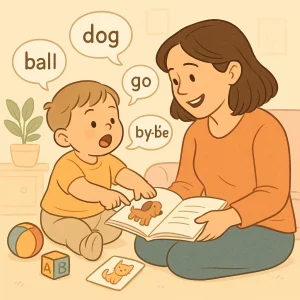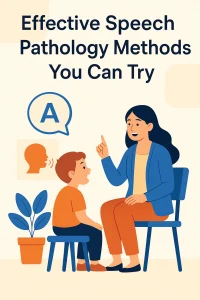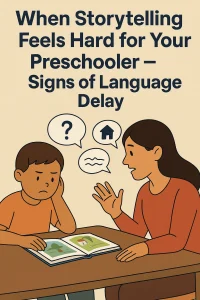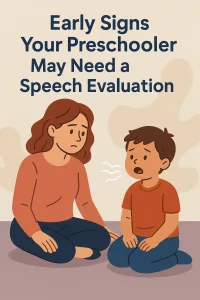Top Speech Therapy Techniques for Parents to Use at Home
By Wellness Hub
Last Updated: October 21, 2024
Imagine helping your child unlock the power of words right from the comfort of your home. Speech therapy is a critical tool for children with speech delays or communication disorders, and when parents engage in the process, the results can be transformative. By incorporating simple yet effective speech therapy techniques at home, you not only strengthen your child’s communication skills but also build a deeper connection with them. These techniques empower parents to become active participants, fostering faster progress and better engagement. Dive in to discover how speech therapy at home can make a world of difference for your child’s development.
What is Speech Therapy?
Speech therapy is a specialized service that helps children improve their communication skills. Its primary goal is to assist children who experience speech delays, articulation disorders, and language issues in developing clear and effective speech. By targeting specific speech and language challenges, speech therapy provides tailored interventions that empower children to express themselves confidently.
Speech therapy covers a wide range of areas:
- Articulation: Focuses on helping children pronounce sounds clearly, correcting any speech errors that may hinder understanding.
- Fluency: Helps children who stutter or have difficulties speaking smoothly.
- Language Comprehension: Enhances a child’s ability to understand and process spoken language, improving both verbal and non-verbal communication.
- Social Communication Skills: Teaches children how to interact appropriately with others, fostering stronger social bonds and improving communication in everyday settings.
Through speech therapy, children gain essential skills that support their overall development, ensuring they can communicate effectively at home, school, and beyond.
Why Speech Therapy at Home?
Speech therapy at home offers numerous benefits that can help reinforce skills learned in professional sessions. By continuing speech therapy techniques at home, parents can create a supportive environment that promotes faster progress in their child’s speech development.
Benefits of Continuing Speech Therapy Techniques at Home:
- Consistency: Reinforcing techniques daily can lead to quicker results.
- Comfort: Children feel more relaxed in familiar settings, making them more open to practice.
- Personalization: Parents can tailor activities to suit their child’s interests, encouraging more engagement.
- Cost-Effective: Regular practice at home reduces the need for additional therapy sessions.
- Parent Involvement: Allows parents to take an active role, fostering stronger communication bonds with their child.
Empowering Parents to Support Speech Development at Home:
- Simple Tools: Use everyday items, like books and toys, to build language skills.
- Interactive Play: Games and interactive activities make learning fun and engaging.
- Modeling: Parents can model proper pronunciation and encourage imitation.
- Routine Integration: Incorporate speech exercises into daily routines, like mealtime or playtime.
- Positive Reinforcement: Celebrate small successes to motivate continued effort.
Common Speech Therapy Techniques to Practice at Home
| Technique | Description |
|---|---|
| Articulation Therapy | Exercises designed to help children pronounce words and sounds correctly, focusing on specific speech sounds they struggle with. |
| Language Intervention Therapy | Engages children in role-playing and language games to improve sentence formation, boost vocabulary, and enhance language use. |
| Modeling and Expansion | Parents model correct sentences and expand on the child’s speech to build their communication skills and encourage clearer speech. |
| Parallel Talk & Self-Talk | Parents describe the child’s or their own actions aloud, helping children associate words with actions and develop language. |
| Use of Visuals | Picture boards, flashcards, and other visuals reinforce language learning and assist children in understanding new vocabulary. |
| Repetition and Positive Reinforcement | Repeating words or sentences strengthens language skills, while praise encourages children to stay motivated and engaged. |
These common speech therapy techniques can significantly support a child’s language development at home. Incorporating these methods into daily routines makes learning natural and fun, while consistent practice ensures lasting improvement. Parents and caregivers play a key role in shaping their child’s speech and language skills by using these techniques regularly.
Also read: Speech Therapy at Home: A Simple Guide for Parents to Help Kids
Practical Tips for Parents Implementing Speech Therapy at Home
- Consistency is Key: Practice regularly to help your child reach speech therapy goals. Even a few minutes each day can reinforce their progress and improve speech skills.
- Interactive Play: Make speech therapy fun with activities like “sabotage” games, where you pretend to “forget” items during play, prompting your child to correct you. Singing familiar songs can also encourage speech in a playful way.
- Giving Choices: Offer simple choices, like “Do you want juice or water?” This not only empowers your child but also encourages them to use their words to communicate decisions.
- Waiting for Responses: After asking a question, give your child a few seconds to think and respond. This technique allows them to form and articulate their thoughts, promoting better speech development.
Specialized Techniques for Children with Specific Speech Disorders
Helping children overcome speech disorders can be challenging, but there are specialized techniques that parents and caregivers can use to support their child’s communication development. Below is a table that highlights key techniques tailored to specific speech disorders, along with practical examples for parents.
| Speech Disorder | Techniques | Examples for Parents |
|---|---|---|
| Children with Apraxia | Focus on oral-motor exercises and speech sound assessments to improve pronunciation. | Example: Encourage your child to blow bubbles or use a straw to drink, which strengthens oral muscles needed for clear speech. |
| Children with Autism | Use non-verbal communication aids such as sign language or picture boards to improve interaction. | Example: Create a picture board with images representing everyday needs (food, drink, toys), so your child can point to communicate. |
| Children with Stuttering | Behavioral techniques like controlling speech rate and using pauses to reduce stuttering. | Example: Practice reading simple sentences with your child. Encourage them to pause after each sentence to slow down their speech. |
Additional Tips for Parents:
- For Apraxia: Try incorporating fun games like repeating simple syllables (“ma-ma,” “da-da”) or using mirrors to help your child see how their mouth moves when forming words.
- For Autism: Engage in activities like story-time using books with both words and pictures, allowing your child to point at images while you narrate. This helps them connect language with visual cues.
- For Stuttering: Make speaking a stress-free activity. Encourage your child to talk about their day and reassure them that it’s okay to take their time.
These techniques, when applied consistently, can make a significant difference in helping children with speech disorders. Remember to celebrate small improvements and provide positive reinforcement to keep your child motivated.
Tools and Resources for Parents
Speech Therapy Apps and Online Resources
Parents today have access to a wide range of digital tools and apps that can enhance their child’s speech therapy at home. Using apps specifically designed for speech development, like the Autism Basics App, provides interactive and engaging exercises that help reinforce the work done during therapy sessions. These tools offer fun and educational ways for children to practice sounds, words, and sentences, making learning enjoyable. Additionally, online resources such as Tele-BASICS – The Perfect Tool for Online Therapy, provide parents with virtual support, offering valuable insights, exercises, and personalized sessions. Incorporating these resources can significantly boost your child’s speech progress at home.
Consulting with Speech Therapists
While digital tools are a great asset, continuous guidance from a professional speech therapist is crucial. Consulting regularly with a therapist ensures that the exercises and strategies you use at home are tailored to your child’s specific needs. A speech therapist can provide valuable feedback on your child’s progress and suggest modifications to home practices, ensuring they remain effective. This professional insight makes a huge difference in your child’s speech development journey, helping parents feel more confident and empowered in their role. Regular check-ins with a therapist can also help track milestones and adjust therapy goals for better outcomes.
By using these tools and maintaining close contact with a professional, parents can create a more dynamic and effective speech therapy environment at home.
Conclusion
In conclusion, parents and caregivers play a vital role in their child’s speech development. By practicing consistent speech therapy at home, engaging with speech therapy activities, and providing positive reinforcement, you can help your child overcome speech delays. Remember, early involvement and dedicated efforts can make a significant difference in your child’s communication skills. If you’re seeking more guidance or resources, explore options like Wellness Hub for expert advice on speech therapy for kids with speech delays. Taking the first step now ensures your child is on the right path to effective speech development.
Frequently Asked Question
1. What is speech therapy at home, and how does it work?
Speech therapy at home involves parents or caregivers using specific techniques to help their child with speech and language development in a comfortable environment. It allows for consistent practice outside of formal therapy sessions and helps reinforce learning through everyday activities.
2. Which speech therapy techniques can I use at home with my child?
Parents can use techniques such as articulation therapy, modeling correct speech, self-talk, parallel talk, and using visual aids like flashcards. These methods help improve speech clarity, expand vocabulary, and develop communication skills.
3. How can I help my child improve speech sounds at home?
Focus on articulation exercises, where the child practices pronouncing specific sounds and words. You can use games, mirror exercises, and repetition to make learning fun and engaging while ensuring the child masters difficult sounds.
4. How much time should I spend on speech therapy at home?
Consistency is key. Ideally, spend 15-30 minutes daily practicing speech therapy activities with your child. Break it into smaller sessions throughout the day to keep the child engaged without overwhelming them.
5. What are the best tools to use for speech therapy at home?
Flashcards, speech therapy apps, picture boards, and articulation games are great tools to support speech therapy at home. These resources make it easier for children to visualize and understand words while practicing speech sounds.
6. Can I do speech therapy at home without professional guidance?
While parents can implement many helpful techniques, consulting with a speech therapist ensures the therapy is tailored to the child’s specific needs. A professional can provide customized exercises and monitor progress.
7. What should I do if my child isn’t making progress with speech therapy at home?
If progress is slow, consult a speech-language pathologist (SLP) to evaluate your child’s needs. The SLP can adjust the therapy plan, recommend new strategies, or identify any underlying issues that may require further attention.
8. How can I make speech therapy at home fun for my child?
Incorporate speech exercises into playtime, use games like “sabotage,” sing songs, and offer choices during activities. Keeping the sessions light and interactive makes learning enjoyable for the child.
9. At what age should I start speech therapy at home?
Speech therapy can begin as early as 12 months if a child shows signs of speech delays. However, early intervention is key, so consult a speech therapist if you notice any delay in your child’s language milestones.
10. Can speech therapy at home help with stuttering?
Yes, speech therapy at home can be beneficial for children who stutter. Techniques like controlling speech rate, using pauses, and practicing slow speech are effective ways to reduce stuttering. It’s best to combine these with professional therapy sessions for optimal results.
About the Author:
Shravanaveena Gajula
M.Sc ., Speech and Language Pathology (9+ years of experience)
Shravanaveena Gajula is a dedicated Audiologist and Speech-Language Pathologist with a BASLP and an M.Sc in Speech and Language Pathology. With experience spanning multiple settings, including Wellness Hub and Ashray Akruti, Veena specializes in a wide range of disorders from developmental issues in children to speech and language assessments in adults. Her expertise includes parent counseling, managing speech sound and fluency disorders, and creating individualized therapy programs. Veena is also PROMPT certified and an author of several insightful blogs on speech and language pathology, aiming to educate and assist caregivers in supporting their loved ones.
Book your Free Consultation Today
Parent/Caregiver Info:
Client’s Details:
* Error Message









